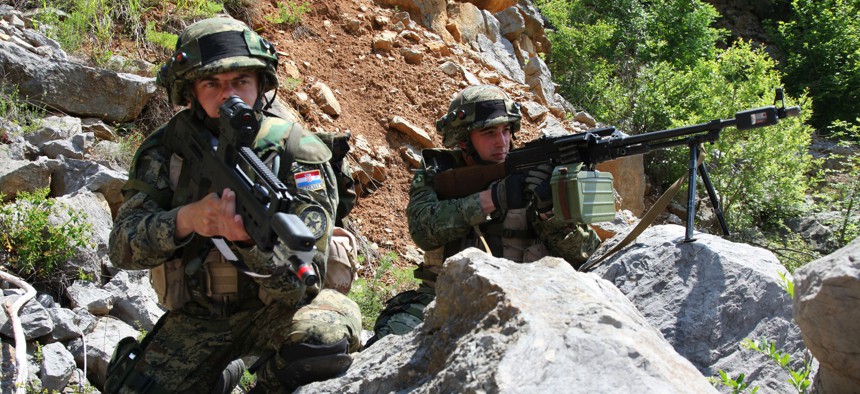
Two Croatian soldiers from 1st Platoon, 1st Company, Tiger Battalion, take cover and provide security as their platoon conducts a movement to contact exercise during the Immediate Response 2012 (IR12) training event held in Croatia on May 29, 2012. U.S. Army photo by SPC Lorenzo Ware
Here’s a 6-Country Defense-Development Effort That Just Might Work
Among its lessons: sometimes, small is better.
It’s a fantastic idea, in theory, for countries to jointly develop and procure weapons. Why not team up, share the development costs, and use economies of scale to lower the purchase price? Alas, most such efforts run into cost overruns and performance problems. But a distinctly unexpected cast is showing that there’s hope yet for joint weapons development, especially as the nature of weaponry is changing.
Austria, Croatia, Hungary, Slovenia, Slovakia, and the Czech Republic have teamed up to develop a new sensor network to detect weapons of mass destruction. “We already have existing defence cooperation agreements between our various countries,” Ales Mismas, director-general of defence policy at the Slovenian Ministry of Defense, told me. “But we wanted to do more. We wanted to show that smaller countries can play a larger role in European defense.”
Indeed, Slovenia’s population of 2.1 million is one of the smallest in NATO and the EU. But when it comes to developing new defense equipment, being small may not be such a disadvantage after all. When larger countries team up to develop new military kit, they bring with them large domestic industries and the pride that comes with being a leading nation. Rather naturally, each partner wants a good product — but they also want the maximum number of jobs in their own countries, and specifications that suit their own armed forces. The result is often far from ideal, mostly through no fault of the manufacturers. Though the countries need the same kind of equipment, each national specification adds time and expense, while further complicating the design. It’s no surprise then, that every major joint procurement project over the past several decades has been plagued by both delays and cost overruns.
Enter Mismas and his colleagues. Along with five Central European partners (Austria, Hungary, Croatia, Slovakia, and the Czech Republic), the Slovenians are developing a pioneering software sensor network to detect any biological, chemical, nuclear, or radiological threat. Their approach: put sensors on unmanned ground vehicles and aerial drones that can be deployed in danger zones and beyond line of sight. Any information gathered will be transmitted and collected by software in real time; it can then immediately be shared among the partners.
Related: Trump Is Choosing Eastern Europe
Related: The Coming Split in NATO
Related: Army Chief: The US Needs More Troops in Europe
The sextet forms a most unusual defence development alliance known as the Central European Defence Cooperation. None of them have large domestic defence industries, and as a result, they have a tradition of buying off the shelf. And precisely because they don’t have a tradition as major arms-producing countries, they have the liberty to experiment. For the sensor network, the four partners selected 13 local companies as industry partners. “It doesn’t matter whether your domestic defence industry is large or small,” Mismas pointed out. “Smaller countries can put together a project that matters to all of the EU and all of NATO.”
That’s especially true, of course, if the project concerns novel equipment. Indeed, the ways that the nature of warfare is changing provide an opening for non-traditional defense-equipment countries. "Though we're small, we don't just want to rely on third parties. Rather, we want to show that we can make a difference with an innovative concept," explained Maj. Gen. Johann Frank, Austria's director of defence policy, the driving force behind the development alliance.
A prototype of the WMD sensor network is planned for the end of 2020. If the effort is selected by PESCO (the EU’s Permanent Structured Cooperation) as an official project and receives funding from the new European Defence Fund, it will go into production. The group then intends to sell the network to allies. It stands to reason that they could even lease access to the network while maintaining full use of it themselves. Call it defense equipment for the Zipcar age.
The sextet’s cooperation – conducted through constant communication between the four defence ministries, who also agreed not to insert any national specifications into the project – is a model that other countries can learn from. Several have already inquired about the project, “both about the content but also the methodology,” Frank said. In a humble turn, one major European country has even inquired about joining the project.
One of Europe’s giants joining a defense-industrial development launched by Austria? If nothing else, it shows that weapons cooperation is in such urgent need of being shaken up that dark horses have a shot at success. Of course, virtually every country needs reliable WMD detection. There should be plenty of scope for other countries to team up in unexpected groupings.
